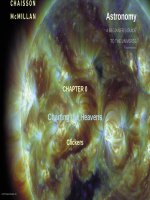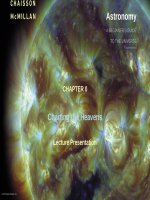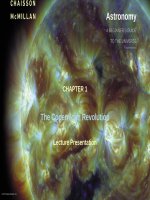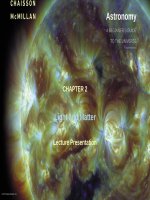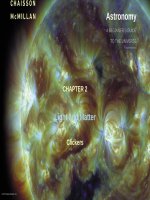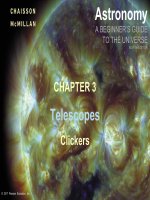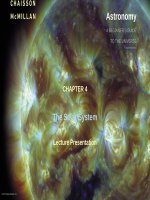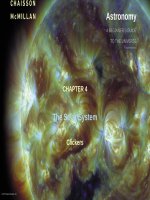Astronomy a beginners guide to the universe 8th CHaisson mcmillan chapter 02
Bạn đang xem bản rút gọn của tài liệu. Xem và tải ngay bản đầy đủ của tài liệu tại đây (3.33 MB, 37 trang )
Astronomy
A BEGINNER’S GUIDE
TO THE UNIVERSE
EIGHTH EDITION
CHAPTER 2
Light and Matter
Lecture Presentation
© 2017 Pearson Education, Inc.
Chapter 2 Light and Matter
© 2017 Pearson Education, Inc.
Units of Chapter 2
•
•
•
•
•
•
•
•
Information from the Skies
Waves in What?
The Electromagnetic Spectrum
Thermal Radiation
Spectroscopy
Formation of Spectral Lines
The Doppler Effect
Summary of Chapter 2
© 2017 Pearson Education, Inc.
2.1 Information from the Skies
•
Electromagnetic radiation: Transmission of energy through space without physical
connection through varying electric and magnetic fields
–
Example: Light
© 2017 Pearson Education, Inc.
2.1 Information from the Skies
•
Wave motion: Transmission of energy without the physical transport of material
© 2017 Pearson Education, Inc.
2.1 Information from the Skies
•
Example: Water wave
–
–
Water just moves up and down.
Wave travels and can transmit energy.
© 2017 Pearson Education, Inc.
2.1 Information from the Skies
•
•
•
Frequency: Number of wave crests that pass a given point per second
Period: Time between passage of successive crests
Relationship:
period = 1 / frequency
© 2017 Pearson Education, Inc.
2.1 Information from the Skies
•
•
•
Wavelength: Distance between successive crests
Velocity: Speed at which crests move
Relationship:
velocity = wavelength / period
© 2017 Pearson Education, Inc.
2.2 Waves in What?
•
Diffraction: The bending of a wave
around an obstacle
•
Interference: The sum of two waves;
may be larger or smaller than the original
waves
© 2017 Pearson Education, Inc.
2.2 Waves in What?
•
Water waves, sound waves, and so on,
travel in a medium (water, air, etc.).
•
Electromagnetic waves need no medium.
•
Created by accelerating charged
particles
© 2017 Pearson Education, Inc.
2.2 Waves in What?
•
•
Magnetic and electric fields are inextricably intertwined.
A magnetic field, such as Earth’s shown here, exerts a force on a moving
charged particle.
© 2017 Pearson Education, Inc.
2.2 Waves in What?
•
Electromagnetic waves: Oscillating electric and magnetic fields; changing electric field
creates magnetic field and vice versa
© 2017 Pearson Education, Inc.
2.3 The Electromagnetic Spectrum
•
•
Different colors of light are distinguished by their frequency and wavelength.
The visible spectrum is only a small part of the total electromagnetic spectrum.
© 2017 Pearson Education, Inc.
2.3 The Electromagnetic Spectrum
•
Different parts of the full electromagnetic spectrum have different names, but there is no
limit on possible wavelengths.
© 2017 Pearson Education, Inc.
2.3 The Electromagnetic Spectrum
•
Note that the atmosphere is only transparent at a few wavelengths—the visible, the near
infrared, and the part of the radio spectrum with frequencies higher than the AM band. This
means that our atmosphere is absorbing a lot of the electromagnetic radiation impinging
on it and also that astronomy at other wavelengths must be done above the atmosphere.
•
Also note that the horizontal scale is logarithmic— each tick is a factor of 10 smaller or
larger than the next one. This allows the display of the longest and shortest wavelengths
on the same plot.
© 2017 Pearson Education, Inc.
2.4 Thermal Radiation
•
Blackbody spectrum: Radiation emitted by an object depending only on its temperature
© 2017 Pearson Education, Inc.
More Precisely 2.1: The Kelvin Temperature Scale
•
Kelvin temperature scale:
–
–
All thermal motion ceases at 0 K.
Water freezes at 273 K and boils at 373
K.
© 2017 Pearson Education, Inc.
2.4 Thermal Radiation
•
Radiation laws:
1.
Peak wavelength is inversely
proportional to temperature.
© 2017 Pearson Education, Inc.
2.4 Thermal Radiation
•
Radiation laws:
2.
© 2017 Pearson Education, Inc.
Total energy emitted is proportional to fourth power of temperature.
2.5 Spectroscopy
•
Spectroscope: Splits light into component colors
© 2017 Pearson Education, Inc.
2.5 Spectroscopy
•
Emission lines: Single frequencies emitted by particular atoms
© 2017 Pearson Education, Inc.
2.5 Spectroscopy
•
The emission spectrum can be used to identify elements.
© 2017 Pearson Education, Inc.
2.5 Spectroscopy
•
Absorption spectrum: If a continuous spectrum passes through a cool gas, atoms of the
gas will absorb the same frequencies they emit.
© 2017 Pearson Education, Inc.
2.5 Spectroscopy
•
Absorption spectrum of the Sun
© 2017 Pearson Education, Inc.
2.5 Spectroscopy
•
Kirchhoff’s laws:
–
–
–
Luminous solid, liquid, or dense gas produces continuous spectrum.
Low-density hot gas produces emission spectrum.
Continuous spectrum incident on cool, thin gas produces absorption spectrum.
© 2017 Pearson Education, Inc.
